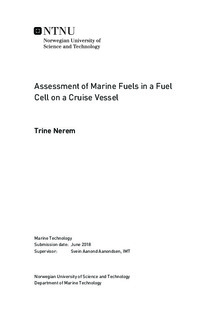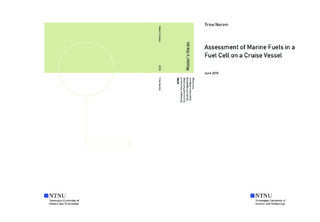| dc.description.abstract | Humans have explored the world through cruise vessels for several years. Most of the vessels use Heavy Fuel Oil (HFO) or Marine Diesel Oil (MDO). Simultaneously, the world is facing an environmentally challenge. Though shipping is the most environmentally friendly and efficient transport mode, it contributed 2.6 % of global emissions of CO2 in 2012. In 2015, 195 of the world s nations signed the Paris Agreement, and by that committed to implement actions to prevent the global temperature rise to exceed 2 degrees. Additionally, International Convention for the Prevention and Pollution from Ships (MARPOL) has strict regulations regarding emissions from ships.
Fuel combustion has a huge affect on the environment, and ship propulsion accounts for approximately 80 % of the environmental impact for a container ship. It is reasonable to assume this will be about equivalent for a cruise vessel. Utilization of another fuel than HFO and MDO may reduce vessel s environmental footprint. Additionally, as an alternative to traditional combustion engines, Fuel Cell (FC) is assumed to be one of the most auspicious future technology.
This thesis contains an evaluation of hydrogen, Liquid Natural Gas (LNG) and methanol in an FC on a cruise vessel. The fuels will be compared based on the space they require on board the vessel, their environmental impact and their Life Cycle Costs (LCC).
An FC consist of an anode and a cathode with an electrolyte between them. In the process, chemical energy will convert to water and electrical energy. The most common way to produce electricity through FCs are by hydrogen and oxygen. FCs can be divided into different types based on the material used in their membrane. They differ in power output, operation temperature, start-up time, typical applications and electrical deficiencies. FCs can be divided into three main categories:
Low-Temperature Fuel Cells (LT-FCs)
Having an operation temperature of approximately 80 degree C
Intermediate temperature FCs
Having an operation temperature of approximately 200 degree C
High-Temperature Fuel Cells (HT-FCs)
Having an operation temperature of approximately 650-1000 degree C
HT-FCs have increased overall efficiency, and does not need an external reformer when other fuels than hydrogen is utilized. Though, they are not as flexible and commercially available as LT-FCs. A Proton Exchange Membrane Fuel Cell (PEMFC), which is an LT-FC, has been found as most suitable for a cruise vessel, and is considered in this thesis calculations. The need of an external reformer when utilization of other fuels than hydrogen in PEMFC, causes both increased machinery size and costs. Hence, the final result would probably have been different if another FC had been chosen.
Required spaces are found by the System Based Ship Design (SBSD) method. A purpose with SBSD is to determine Gross Tonnage (GT), Gross Volume (GV) and main dimensions for a specific vessel. To implement this, necessary areas and volumes of all equipment needed in the vessel should be determined. In this thesis, a tank capacity making it possible to sail 100 hours without bunkering is required. It was found that whether to use hydrogen, LNG or methanol as fuel does not cause any significant variations in a vessel s main dimensions. LNG causes smallest dimensions, while hydrogen and methanol cause equals dimensions, considering the system boundaries given in this thesis. HFO causes the highest dimensions, which is mainly due to the size of the combustion engine. If the tank size is increased even more, the result would have been different.
The fuels potential environmental impact has been found by a Life Cycle Assessment (LCA). Hydrogen produced from renewable energy sources has the smallest potential environmental footprint, while hydrogen produced from Natural Gas (NG) has the highest impact. Furthermore, it was found that LNG utilized through an FC is, from an environmental point of view, a better solution than methanol utilized in an FC. Both LNG and methanol release less emissions as utilized in an FC than a combustion engine.
The economical evaluation is based on LCC. LCC is mainly divided into Capital Expenditures (CAPEX), Operational Expenditures (OPEX) and Voyage Related Expenditures (VOYEX). Methanol, hydrogen and LNG cause 1.15, 1.14 and 1.10 times higher LCC than HFO. | |

